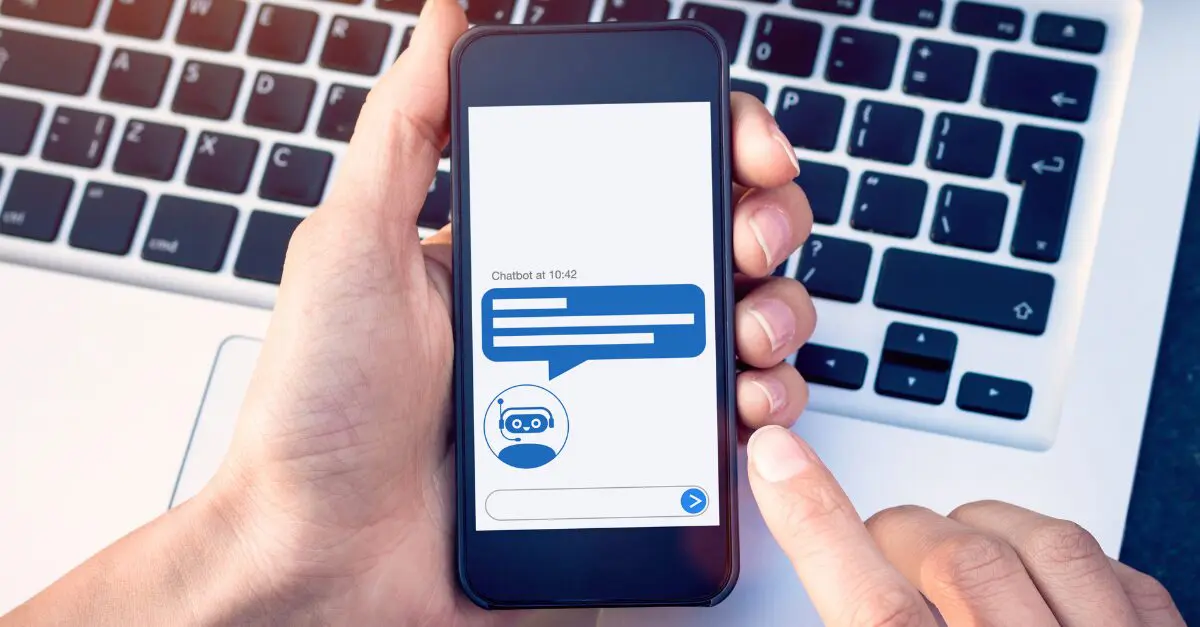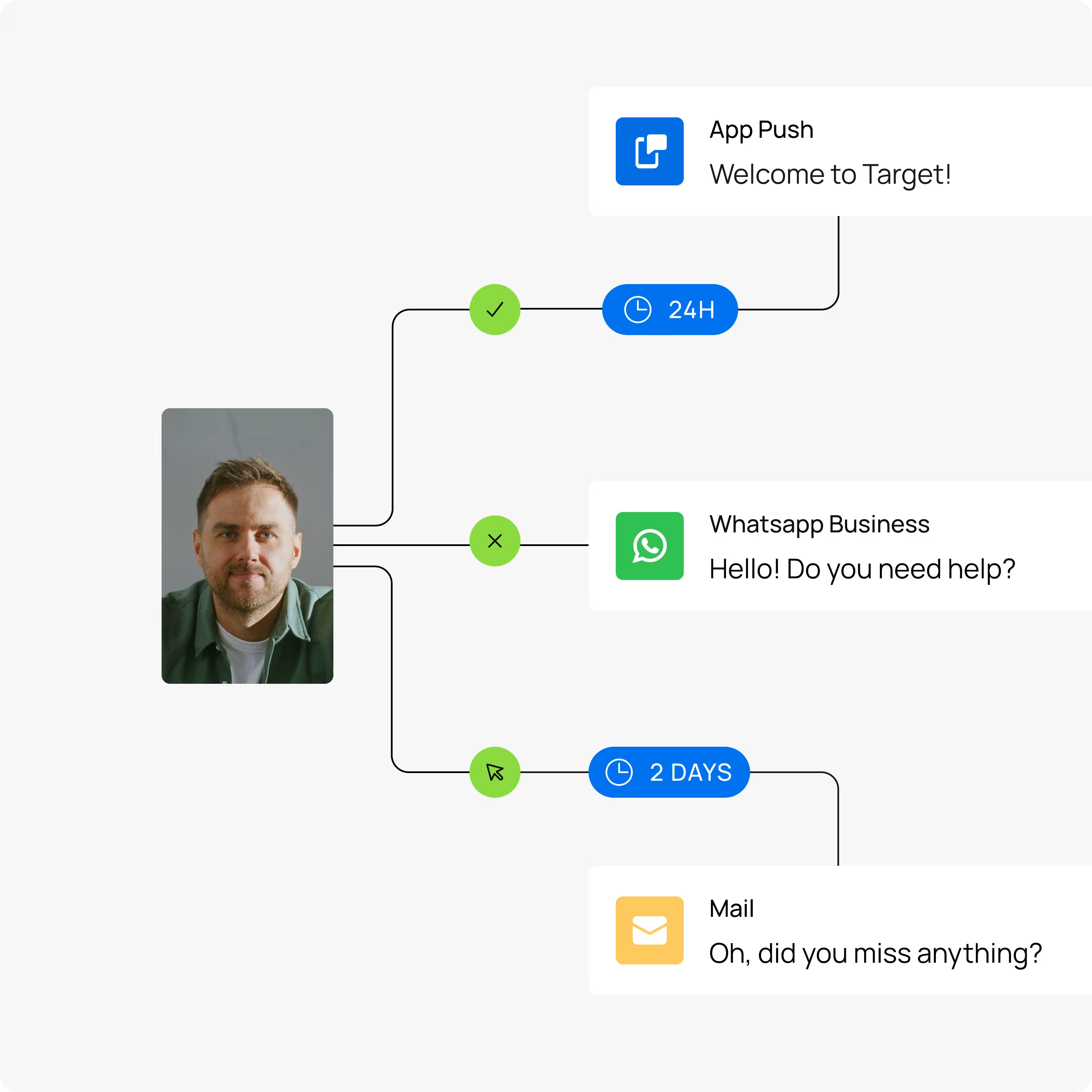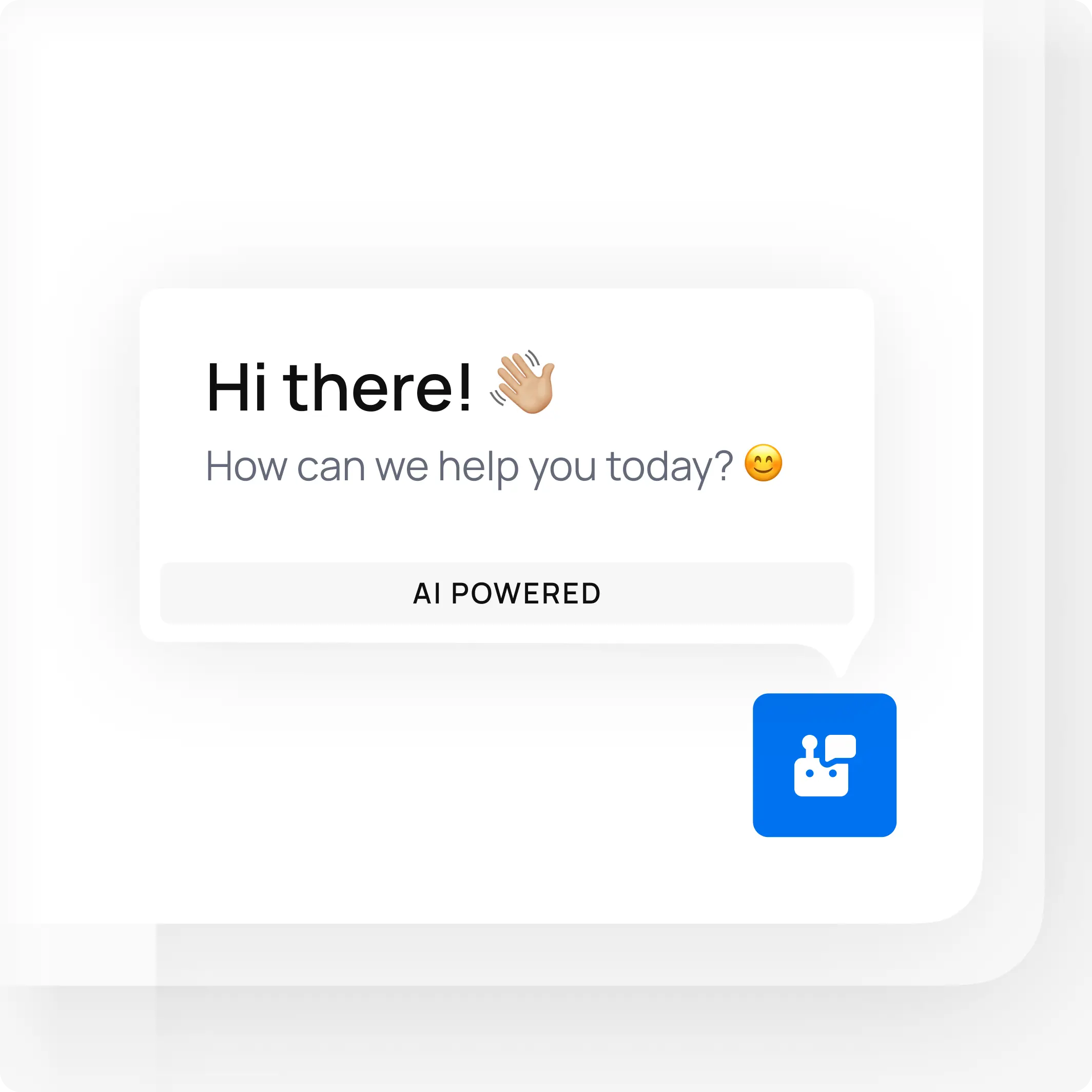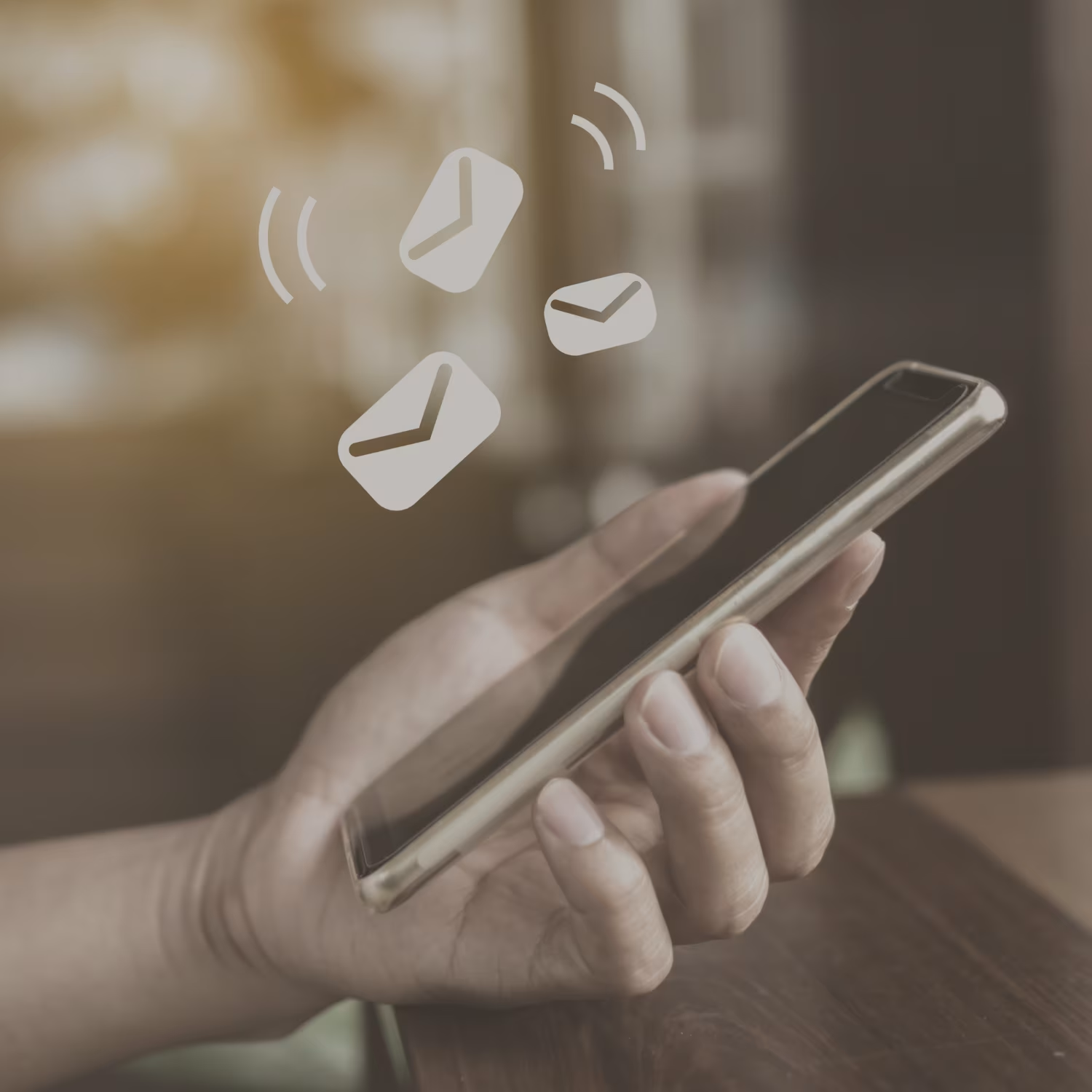Blog
WhatsApp Bot Development: From Concept to Launch


Introduction
WhatsApp has become an integral part of global communication, boasting an impressive user base of nearly 3 billion unique active users worldwide as of June 2024. This staggering reach makes it the most popular mobile messenger app globally, with a presence in over 180 countries and support for 16 languages. WhatsApp’s dominance is particularly evident in mobile-first economies, where it enjoys usage rates of over 90% among digital populations in countries like Nigeria, South Africa, and Brazil.
In recent years, the importance of chatbots in business communication has risen dramatically. As companies seek more efficient and scalable ways to interact with customers, WhatsApp bots have emerged as a powerful solution. These automated conversational agents can handle a wide range of tasks, from customer support to sales inquiries, operating 24/7 without human intervention.
WhatsApp bots are becoming essential for businesses for several reasons:
- Massive reach: With WhatsApp’s enormous user base, businesses can potentially connect with billions of customers through a single platform.
- High engagement: WhatsApp boasts an impressive 98% open rate for messages, significantly outperforming email marketing.
- Cost-effectiveness: Automated responses can handle a large volume of inquiries simultaneously, reducing the need for extensive human resources.
- Personalization: Bots can provide tailored responses based on user data and interaction history, enhancing the customer experience.
- Multichannel integration: WhatsApp bots can be integrated with other business systems, such as CRM and e-commerce platforms, for seamless operations.
- Global accessibility: With WhatsApp’s worldwide presence, businesses can easily expand their reach to international markets.
As of July 2023, over 200 million businesses were actively using WhatsApp Business, demonstrating a growth of over 300% since June 2020. This rapid adoption underscores the increasing recognition of WhatsApp bots as a vital tool for modern business communication and customer engagement.

Understanding WhatsApp Bots
WhatsApp bots are automated software programs designed to interact with users on the WhatsApp platform, simulating human-like conversations and performing various tasks without direct human intervention. They sometimes come packaged with Whatsapp marketing software like indigitall.
Definition and Basic Concepts
A WhatsApp bot is essentially a computer program that uses the WhatsApp Business API to send and receive messages, process user inputs, and provide automated responses or actions. These bots can handle a wide range of functions, from answering simple queries to processing complex transactions.
Types of WhatsApp Bots
There are two main types of WhatsApp bots:
- Rule-based bots: These are the simplest type of WhatsApp chatbots that can be created quickly. They offer a predefined list of options for users to choose from, using interactive buttons in the UI or by replying with specific keywords. While simple, they can be incredibly useful for straightforward tasks and interactions.
- AI-powered bots: These more advanced bots use natural language processing (NLP) to understand user intent and provide more natural, conversational responses. They can interpret various phrasings of the same question and provide appropriate answers, much like virtual assistants such as Alexa or Siri.
Key Features and Capabilities
WhatsApp bots offer a range of features and capabilities:
- 24/7 Availability: Bots can provide instant responses at any time of day.
- Multilingual Support: Many bots can communicate in multiple languages.
- Personalization: Bots can provide tailored responses based on user data and interaction history.
- Multimedia Handling: They can send and receive various types of media, including images, videos, and documents.
- Integration: Bots can connect with other business systems like CRM, e-commerce platforms, and databases.
- Scalability: They can handle multiple conversations simultaneously.
- Analytics: Bots can collect and analyze user interaction data for business insights.
Benefits for Businesses and Users
For Businesses:
- Cost-effectiveness: Bots can handle a large volume of inquiries, reducing the need for extensive human resources.
- Improved Customer Service: They provide instant responses, enhancing customer satisfaction.
- Lead Generation: Bots can qualify leads and gather customer information efficiently.
- Increased Engagement: The ease of interaction can lead to higher customer engagement rates.
- Data Collection: Bots can gather valuable customer data for business insights.
For Users:
- Instant Support: Users can get immediate responses to their queries at any time.
- Convenience: Interactions can be carried out through a familiar and widely-used platform.
- Personalized Experience: Users can receive tailored information and recommendations.
- Simplified Processes: Bots can guide users through complex processes or transactions step-by-step.
- Language Accessibility: Multi-lingual bots can serve users in their preferred language.
WhatsApp bots represent a powerful tool for businesses to enhance customer communication, streamline operations, and provide value to users through automated, intelligent interactions on one of the world’s most popular messaging platforms.
Conceptualizing Your WhatsApp Bot
The first step in developing a successful WhatsApp bot is to clearly conceptualize its purpose, functionality, and target audience. This process involves several key steps:
Identifying Your Business Needs and Goals
Begin by clearly defining what you want to achieve with your WhatsApp bot. Common goals include:
- Improving customer service efficiency
- Generating and qualifying leads
- Automating sales processes
- Enhancing customer engagement
- Reducing operational costs
Prioritize these goals based on your business’s current needs and long-term strategy. This will help guide the bot’s development and ensure it aligns with your overall business objectives.
Defining Your Target Audience
Identify the specific group of users your bot will serve. Consider factors such as:
- Demographics (age, location, language)
- Psychographics (interests, values, lifestyle)
- Behavioral patterns (shopping habits, technology usage)
- Pain points and needs
Understanding your target audience will help you tailor the bot’s functionality and communication style to best serve their needs.
Brainstorming Bot Functionalities
Based on your goals and target audience, brainstorm potential features and functionalities for your bot. These might include:
- Answering frequently asked questions
- Providing product recommendations
- Processing orders and payments
- Scheduling appointments
- Offering personalized promotions
Prioritize these functionalities based on their potential impact and feasibility of implementation.
Creating User Personas and Use Cases
Develop detailed user personas representing your target audience. These fictional characters should embody the characteristics, needs, and behaviors of your typical users. For each persona, create specific use cases that illustrate how they might interact with your bot. This process helps ensure your bot design addresses real user needs and scenarios.
Mapping Out the Conversational Flow
Design the structure of your bot’s conversations by creating a flowchart or decision tree. This should outline:
- The bot’s greeting and introduction
- Main menu options or primary functionalities
- Potential user inputs and corresponding bot responses
- Decision points and branching paths in the conversation
- Error handling and fallback options
- Opportunities for human handover
Consider the logical progression of the conversation and aim for a natural, intuitive flow that guides users towards their goals efficiently.
By thoroughly conceptualizing your WhatsApp bot before development, you’ll create a solid foundation for building a tool that effectively meets both your business needs and user expectations. This planning stage is crucial for ensuring your bot provides value, engages users effectively, and contributes to your overall business strategy.
Choosing the Right Development Approach
When developing a WhatsApp bot, selecting the right approach is crucial for success. While the WhatsApp Business API offers direct access to the platform’s features, third-party solutions like indigitall provide significant advantages that can streamline your development process and enhance your bot’s capabilities.
WhatsApp Business API vs. Third-Party Platforms
While the WhatsApp Business API gives you direct access to WhatsApp’s features, it requires substantial technical expertise and resources to implement effectively. In contrast, third-party platforms like indigitall offer a more accessible and feature-rich alternative.
indigitall stands out by providing a comprehensive suite of tools specifically designed for WhatsApp bot development. Its platform offers:
- Pre-built templates and modules for common bot functionalities
- Advanced analytics and reporting capabilities
- Seamless integration with other business systems
- Robust security features and compliance with WhatsApp’s policies
By leveraging indigitall’s expertise, businesses can significantly reduce development time and costs while still creating highly effective WhatsApp bots.
Evaluating No-Code, Low-Code, and Custom Development Options
When considering development approaches, it’s important to assess your team’s technical capabilities and project requirements:
- No-code solutions: Ideal for businesses with limited technical resources, these platforms allow you to create bots without writing code.
- Low-code platforms: Offer a balance between ease of use and customization, suitable for businesses with some technical expertise.
- Custom development: Provides the most flexibility but requires significant development resources and time. To streamline ongoing deployment, monitoring, and management of these solutions, implementing IT ops automation can help reduce manual effort, increase efficiency, and maintain system reliability.
Factors to Consider When Selecting a Development Method
When choosing your development approach, consider the following factors:
- Time to market
- Budget constraints
- Required features and customization
- Scalability needs
- Integration requirements with existing systems
- Long-term maintenance and support
indigitall addresses these concerns by offering a scalable, feature-rich platform that can grow with your business. Its robust support and continuous updates ensure your WhatsApp bot remains cutting-edge and compliant with WhatsApp’s evolving policies.
In conclusion, while the WhatsApp Business API offers direct access to the platform, third-party solutions like indigitall provide a more comprehensive and accessible approach to WhatsApp bot development. By leveraging indigitall’s expertise and tools, businesses can create sophisticated, scalable WhatsApp bots more efficiently and effectively than through direct API development. This approach not only saves time and resources but also ensures your bot is built on a platform designed for long-term success and growth.

Designing the Bot's Conversation Flow
Creating an effective conversation flow is crucial for the success of your WhatsApp bot. A well-designed flow ensures smooth interactions, enhances user experience, and helps achieve your bot’s objectives.
Creating a Conversational Strategy
Begin by outlining a clear conversational strategy that aligns with your bot’s purpose and user expectations:
- Define the bot’s tone and personality to match your brand voice.
- Identify key conversation points and potential user intents.
- Plan for both happy paths (ideal user journeys) and edge cases (unexpected scenarios).
- Determine when and how to escalate conversations to human agents.
Remember to keep the conversation focused and guide users towards their goals efficiently.
Mapping Out Decision Trees and User Journeys
Visualize your bot’s conversation flow using decision trees or flowcharts:
- Start with a welcoming message that clearly states the bot’s capabilities.
- Create logical branches for different user intents or menu options.
- Design fallback options for when the bot doesn’t understand user input.
- Include loops to allow users to return to previous points in the conversation.
- Incorporate exit points where users can end the conversation or switch to human support.
Use tools like draw.io or specialized bot design platforms to create and refine your flowcharts.
Designing for Natural Language Understanding
While many WhatsApp bots use menu-based interactions, incorporating natural language understanding (NLU) can greatly enhance the user experience:
- Identify common phrases and keywords related to your bot’s functions.
- Create variations of user inputs to train your NLU model.
- Design responses that feel natural and conversational.
- Implement context-awareness to maintain coherence throughout the conversation.
- Regularly analyze user interactions to improve your NLU model over time.
Incorporating Multimedia Elements
Enhance your bot’s communication by integrating various multimedia elements:
- Images: Use product photos, infographics, or branded visuals to illustrate points.
- Videos: Incorporate short clips for tutorials, product demonstrations, or brand messages.
- Documents: Provide PDFs, brochures, or forms when detailed information is needed.
- Interactive buttons: Implement quick reply buttons for common actions or choices.
When using multimedia, ensure that:
- Files are optimized for mobile viewing and quick loading.
- Alternative text options are available for accessibility.
- Multimedia enhances rather than replaces clear textual communication.
By carefully designing your bot’s conversation flow, you create a more engaging, efficient, and user-friendly experience. Remember to test your flow thoroughly and iterate based on user feedback and performance metrics. A well-crafted conversation flow will not only meet user needs but also reflect positively on your brand and potentially increase conversion rates.

Enhancing Bot Intelligence
To create a truly effective and engaging WhatsApp bot, it’s crucial to implement advanced technologies that enhance its intelligence and ability to understand and respond to user inputs naturally.
Implementing Natural Language Processing (NLP)
Natural Language Processing is key to creating a bot that can understand and respond to user messages in a human-like manner:
- Intent recognition: Implement NLP algorithms to identify the user’s intent behind each message.
- Entity extraction: Use NLP to extract important information like dates, names, or product types from user messages.
- Sentiment analysis: Employ NLP to detect the user’s emotional state and adjust responses accordingly.
- Context understanding: Develop your bot to maintain context throughout the conversation for more coherent interactions.
Utilizing NLP frameworks like DialogFlow, Wit.ai, or IBM Watson can significantly streamline this process and improve your bot’s language understanding capabilities.
Training the Bot with Samples
To ensure your bot can handle a wide range of interactions effectively:
- Create a diverse dataset of sample text, pdf, URLs, etc. which cover tone and language for some scenarios and user types.
- Include both positive and negative examples to help the bot understand what constitutes a good or bad response.
- Continuously expand your training dataset with real user interactions to improve accuracy over time.
- Use techniques like transfer learning to leverage pre-trained models and reduce the amount of custom training data needed.
Continuous Learning and Improvement Strategies
To keep your bot relevant and effective:
- Implement feedback loops: Collect user feedback after interactions to identify areas for improvement.
- Analyze conversation logs: Regularly review logs to identify common issues or misunderstandings.
- A/B testing: Experiment with different responses or conversation flows to optimize performance.
- Human-in-the-loop learning: Incorporate human oversight to correct and improve the bot’s responses over time.
- Regular model updates: Retrain your bot’s NLP and ML models periodically with new data to adapt to changing user needs and language patterns.
By focusing on these aspects of bot intelligence, you can create a WhatsApp bot that not only understands and responds to users effectively but also continually improves its performance over time. This approach leads to more engaging, personalized, and valuable interactions for your users, ultimately driving better business outcomes and customer satisfaction.
Testing and Quality Assurance
Thorough testing and quality assurance are crucial steps in ensuring your WhatsApp bot functions correctly, meets user expectations, and complies with security and privacy standards. A well-executed testing strategy can help identify and resolve issues before they impact your users.
To make sure your WhatsApp bot works smoothly, it’s essential to test it thoroughly, addressing any issues before they affect your users. Using AI QA automation can really help here, speeding up the process while improving accuracy. With AI, you can run tests across different situations and catch problems that might slip through manual testing. Plus, it makes it easier to keep testing over time, so your bot stays reliable as it evolves.
Developing a Comprehensive Testing Strategy
Start by creating a robust testing plan that covers all aspects of your bot:
- Define test objectives and scope
- Identify key functionalities to be tested
- Establish testing environments (development, staging, production)
- Create a timeline for different testing phases
- Assign roles and responsibilities to team members
- Determine acceptance criteria for each test type
Conducting Unit and Integration Tests
Unit testing focuses on individual components, while integration testing ensures different parts work together seamlessly:
- Unit Tests:
- Test individual functions and modules
- Verify correct handling of various input types
- Ensure proper error handling and edge cases
- Integration Tests:
- Test interactions between different bot components
- Verify correct data flow between the bot and external systems
- Ensure proper handling of API calls and responses
Use automated testing tools like Jest, Mocha, or PyTest to streamline this process and enable continuous integration.
Performing User Acceptance Testing (UAT)
UAT involves testing the bot from the end-user’s perspective:
- Create a diverse group of test users representing your target audience
- Develop realistic test scenarios based on expected user interactions
- Collect and analyze feedback on usability, functionality, and overall experience
- Identify and prioritize improvements based on UAT results
- Conduct multiple UAT rounds to verify fixes and improvements
Stress Testing for Scalability and Performance
Ensure your bot can handle high volumes of concurrent users and maintain performance:
- Simulate various levels of user load (normal, peak, extreme)
- Monitor response times under different load conditions
- Test the bot’s ability to handle multiple conversations simultaneously
- Verify proper functioning of queuing and load balancing mechanisms
- Identify and address performance bottlenecks
Use tools like Apache JMeter or Gatling for automated stress testing.
Security and Privacy Compliance Checks
Protecting user data and ensuring compliance with regulations is critical:
- Conduct vulnerability assessments and penetration testing
- Verify secure handling and storage of sensitive user information
- Ensure compliance with GDPR, CCPA, and other relevant data protection regulations
- Test authentication and authorization mechanisms
- Verify proper implementation of encryption for data in transit and at rest
- Check for compliance with WhatsApp’s security and privacy policies
Consider engaging third-party security experts for comprehensive security audits.
Additional Testing Considerations
- Regression Testing: Ensure new features or fixes don’t break existing functionality
- Localization Testing: Verify proper functioning across different languages and regions
- Compatibility Testing: Test across various devices and WhatsApp versions
- Error Handling: Verify graceful handling of unexpected inputs or system failures
- Recovery Testing: Ensure the bot can recover from crashes or interruptions
By implementing a thorough testing and quality assurance process, you can significantly improve the reliability, performance, and user satisfaction of your WhatsApp bot. Regular testing throughout the development lifecycle helps identify and resolve issues early, reducing the risk of problems in production and ensuring a smooth user experience.
Launching Your WhatsApp Bot
Launching your WhatsApp bot requires careful planning and adherence to WhatsApp’s policies. Follow these steps to ensure a smooth and compliant launch:
Obtaining Necessary Approvals from WhatsApp
Before launching, you must get WhatsApp’s approval:
- Take your business through a verification process with Meta.
- Submit your proactive messages for review through the WhatsApp Business API.
- Ensure your bot complies with WhatsApp’s Commerce Policy and Business Policy.
- Provide clear descriptions of your bot’s functionality and use cases.
- Be prepared to make adjustments based on WhatsApp’s feedback.
The approval process typically takes 5-7 business days, but can vary depending on your bot’s complexity.
Setting up a WhatsApp Business Account
To use a WhatsApp bot, you need a WhatsApp Business Account (WABA):
- Create a Facebook Business Manager account if you don’t have one.
- Apply for a WhatsApp Business API account through Facebook Business Manager.
- Verify your business details and phone number.
- Once approved, configure your business profile with relevant information.
Configuring Message Templates
Message templates are crucial for initiating conversations:
- Create templates for different scenarios (e.g., welcome messages, order updates).
- Submit templates for WhatsApp approval through Facebook Business Manager.
- Use variables in templates for personalization (e.g., {{1}} for customer name).
- Ensure templates comply with WhatsApp’s guidelines for each category (utility, marketing, authentication).
Implementing Opt-in Mechanisms
WhatsApp requires explicit user consent before sending messages:
- Develop clear opt-in processes on your website, app, or other channels.
- Use checkboxes or toggle switches for users to agree to receive WhatsApp messages.
- Clearly state the types of messages users will receive and how often.
- Implement a double opt-in process for added security and compliance.
- Store opt-in records securely for future reference.
Soft Launch and Beta Testing
Before a full launch, conduct a controlled rollout:
- Start with a small group of beta testers or loyal customers.
- Monitor bot performance, user interactions, and any technical issues.
- Collect feedback on user experience and bot functionality.
- Analyze conversation logs to identify areas for improvement.
- Make necessary adjustments based on beta test results.
- Gradually increase the user base as you refine the bot.
During the soft launch:
- Monitor response times and bot availability closely.
- Have a dedicated team ready to handle any issues that arise.
- Prepare fallback options in case of bot failures or unexpected scenarios.
By following these steps, you can ensure a compliant and successful launch of your WhatsApp bot. Remember that launching is just the beginning – continuous monitoring, optimization, and updates will be necessary to maintain an effective WhatsApp bot presence.
Monitoring and Optimization
Once your WhatsApp bot is live, continuous monitoring and optimization are crucial to ensure its effectiveness and improve its performance over time.
Setting up Analytics and Tracking Tools
Implement robust analytics to gain insights into your bot’s performance:
- Integrate WhatsApp Business API analytics for basic metrics.
- Set up custom tracking for specific user actions or conversion points.
- Implement event tracking to monitor user journey through the bot.
- Consider using heatmaps to visualize user interaction patterns.
Ensure your analytics setup complies with data privacy regulations like GDPR and CCPA.
Monitoring Key Performance Indicators (KPIs)
Track essential metrics to gauge your bot’s success:
- User Engagement:
- Active users (daily, weekly, monthly)
- Message volume
- Conversational Performance:
- Response rate
- Task Completion:
- Goal conversion rate (e.g., purchases, appointments booked)
- Fallback rate (how often the bot fails to understand)
- Human handover rate
- User Satisfaction:
- Customer satisfaction score (CSAT)
- Net Promoter Score (NPS)
- User retention rate
Analyzing User Interactions and Feedback
Dive deep into user behavior to understand your bot’s strengths and weaknesses:
- Review conversation logs to identify common user queries and pain points.
- Analyze user feedback collected through surveys or in-chat ratings.
- Identify drop-off points in the conversation flow.
- Monitor sentiment analysis to gauge user emotions during interactions.
- Track frequently used features vs. underutilized capabilities.
Identifying Areas for Improvement
Based on your analysis, pinpoint aspects of your bot that need enhancement:
- Improve natural language understanding for frequently misunderstood queries.
- Optimize conversation flows that have high drop-off rates.
- Enhance response quality for topics with low user satisfaction.
- Add new features or capabilities based on common user requests.
- Refine the bot’s personality and tone based on user feedback.
Scaling Your WhatsApp Bot
As your WhatsApp bot gains traction and proves its value, scaling becomes crucial to meet growing demands and expand its capabilities. indigitall offers robust solutions to support this scaling process, ensuring your bot can handle increased load and offer enhanced functionalities.
Handling Increased User Load
As your user base grows, your bot needs to maintain performance and responsiveness:
- indigitall’s platform is built for scalability, capable of handling many conversations simultaneously.
- Advanced queueing mechanisms prevent system overload and maintain response times even under high user loads.
Expanding Bot Functionalities
To keep up with evolving user needs, your bot should continuously expand its capabilities:
- indigitall’s AI-powered platform regularly introduces new features.
- Integration with external APIs and services can be easily implemented to enhance bot functionality, such as real-time data retrieval or transaction processing.
Integrating with Additional Channels
While WhatsApp is a powerful platform, expanding to other channels can broaden your reach:
- indigitall offers omnichannel support, allowing your bot to seamlessly operate across multiple platforms.
- Their unified inbox integrates conversations from various channels, including Facebook Messenge, providing a consistent user experience.
- Cross-channel analytics help you understand user behavior across different platforms and optimize your bot’s performance accordingly.
Implementing Multi-Language Support
To cater to a global audience, multi-language support is essential:
- indigitall’s platform supports multiple languages out of the box, allowing your bot to communicate with users in their preferred language.
- Their advanced natural language processing (NLP) capabilities ensure accurate understanding and response generation across different languages.
- Centralized content management allows for easy translation and localization of bot responses.
How indigitall Supports Scaling
indigitall provides comprehensive support for scaling your WhatsApp bot:
- Effortless Interactions: Their AI Chatbot enables real-time conversations with customers at scale, supporting multiple channels and languages.
- Real-Time Customer Journeys: indigitall’s platform allows you to gather customer data and instantly create personalized journeys, adapting to increased user volumes and diverse needs.
- Seamless CRM Integrations: As you scale, indigitall ensures your growing customer data is easily shared with your CRM, eliminating data silos and manual uploads.
- Advanced Analytics: Their platform offers robust analytics tools to monitor bot performance, user engagement, and conversion rates as you scale, enabling data-driven optimizations.
- Continuous Learning: indigitall’s AI-powered system continuously learns from interactions, improving response accuracy and relevance as your user base grows.
By leveraging indigitall’s powerful platform, you can confidently scale your WhatsApp bot to meet increasing demands, expand its capabilities, and provide a seamless, personalized experience across multiple channels and languages. Their comprehensive solution ensures that as your bot grows, it continues to deliver high-quality, efficient customer engagement that aligns with your brand’s standards
WhatsApp Chatbot Best Practices and Tips
To create an effective and engaging WhatsApp bot, consider the following best practices and tips:
Designing for User Experience
- Keep conversations natural and concise. Use a conversational tone and provide quick replies to maintain flow.
- Optimize for speed and efficiency. Ensure rapid response times to enhance user experience.
- Follow the “Three-Clicks Rule”: Users should be able to achieve their goal within three interactions after the initial greeting.
- Use multimedia elements like images, videos, and buttons to make interactions more engaging and intuitive.
- Implement personalized greetings and responses based on user data and past interactions.
Maintaining Brand Consistency
- Create a bot persona that aligns with your brand voice. Decide whether to use formal or informal language, and whether humor is appropriate.
- Be transparent about the bot’s identity. Inform users they’re interacting with a chatbot and consider giving it a name.
- Ensure the bot’s responses and tone are consistent with your brand’s overall communication style.
- Use visual elements like logos and brand colors in the bot’s interface to reinforce brand identity.
Ensuring Data Privacy and Security
- Comply with data protection regulations like GDPR and CCPA.
- Implement encryption for data in transit and at rest.
- Clearly communicate your data handling practices to users.
- Regularly audit and update your security measures to protect user information.
- Only collect and store essential user data, and provide options for users to manage their data.
Keeping the Conversation Human-like
- Use natural language processing (NLP) to understand user intent and provide contextually relevant responses.
- Incorporate empathy into the bot’s responses, acknowledging user emotions when appropriate.
- Use varied responses to avoid repetition and maintain a natural feel.
- Include small talk capabilities to handle off-topic queries gracefully.
- Implement typing indicators and slight delays to mimic human conversation patterns.
Providing Seamless Human Handover Options
- Clearly communicate when and how users can switch to a human agent.
- Implement triggers that automatically escalate complex issues to human support.
- Ensure a smooth transition of context and conversation history when handing over to a human agent.
- Provide options for users to schedule callbacks or leave messages for human follow-up.
- Use AI to prioritize and route handover requests to the most appropriate human agents.
By following these best practices and tips, you can create a WhatsApp bot that not only meets functional requirements but also provides a positive, brand-consistent user experience while maintaining security and trust. Remember to continuously gather user feedback and iterate on your bot’s design and functionality to ensure it remains effective and relevant over time.
Future Trends in WhatsApp Bot Development
As WhatsApp bots continue to evolve, several exciting trends are shaping their future development:
Advancements in AI and Machine Learning
The integration of more sophisticated AI and machine learning models is set to revolutionize WhatsApp bot capabilities:
- Enhanced Natural Language Processing (NLP) will enable bots to understand and respond to complex queries with greater accuracy.
- Machine learning models will continuously improve bot performance, learning from each interaction to provide more personalized and contextually relevant responses.
- Advanced sentiment analysis will allow bots to better gauge user emotions and adjust their responses accordingly, leading to more empathetic interactions.
Integration with Voice Assistants
The convergence of text-based chatbots and voice assistants is on the horizon:
- WhatsApp bots may soon offer voice interaction options, allowing users to send voice messages and receive spoken responses.
- Integration with popular voice assistants like Siri or Google Assistant could enable users to interact with WhatsApp bots through these platforms, expanding accessibility.
Augmented Reality (AR) Experiences
AR integration is poised to transform user interactions with WhatsApp bots:
- Businesses incorporating AR capabilities into their WhatsApp bots can expect a 30-35% increase in conversion rates.
- AR features could allow users to virtually try on products, visualize furniture in their homes, or receive visual step-by-step guidance for product assembly or troubleshooting.
Predictive and Proactive Bot Behaviors
Future WhatsApp bots will become more anticipatory and proactive:
- Leveraging user data and behavior patterns, bots will predict user needs and offer solutions before they’re explicitly requested.
- Proactive messaging capabilities will enable bots to initiate conversations for various purposes, such as order updates, appointment reminders, or personalized promotions.
- Advanced analytics will allow bots to identify trends and patterns in user behavior, enabling businesses to optimize their offerings and communication strategies.
As these trends continue to develop, WhatsApp bots are set to become even more integral to business operations and customer interactions. The future of WhatsApp bot development promises more intuitive, efficient, and engaging conversational experiences that blur the line between human and AI interaction.
Conclusion
In summary, WhatsApp bots represent a transformative tool for businesses looking to enhance customer communication and engagement. Throughout this discussion, we have explored the essential components of WhatsApp bot development, from conceptualization and design to testing and optimization. Key points include the importance of creating a user-friendly conversational flow, leveraging advanced AI technologies, and ensuring robust security measures.
As we look to the future, the role of WhatsApp bots in business communication is set to expand significantly. With over 2 billion active users and increasing adoption among businesses, WhatsApp is becoming the go-to platform for direct customer interactions. The integration of sophisticated conversational AI, machine learning capabilities, and features like augmented reality will further enhance the effectiveness of these bots. Businesses that embrace these advancements can expect improved customer satisfaction, increased engagement, and higher conversion rates.
We encourage businesses to take advantage of WhatsApp bot technology as part of their communication strategy. By implementing a well-designed bot, companies can not only streamline their operations but also create meaningful connections with their customers. As trends in messaging continue to evolve, those who adapt and innovate will undoubtedly gain a competitive edge in their respective markets. Embrace the future of business communication with WhatsApp bots and unlock new opportunities for growth and success.












